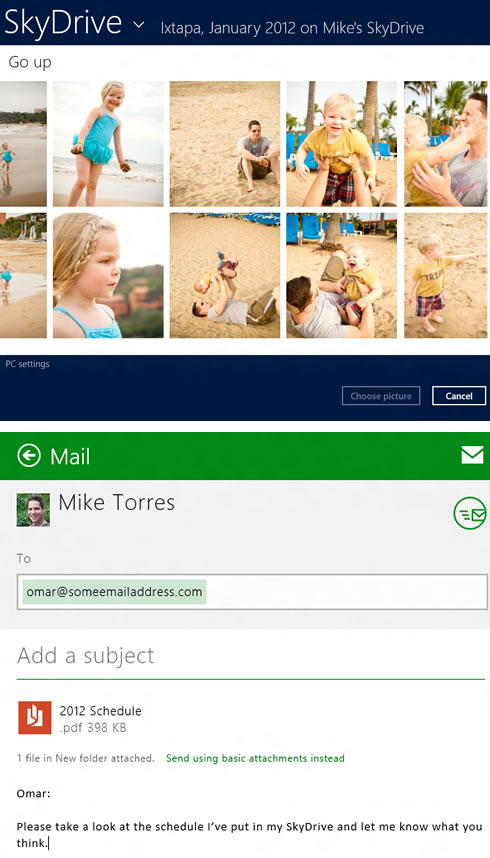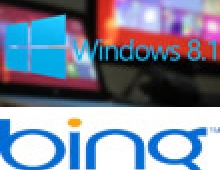
SkyDrive and Windows 8
Microsoft shared the details of a key step the company is taking with Windows 8 towards its vision of personal cloud storage.
The company described how it plans to scale its services to billions of people, and some of the coming improvements, including a new Metro style app for Windows 8, SkyDrive integration in Windows Explorer, and the ability to fetch any file remotely from SkyDrive.com.
With the SkyDrive app, an early version of which will be available at Consumer Preview, Microsoft focused on designing a fast, touch-first version of SkyDrive that makes it easy to browse and access your files. Microsoft will also make SkyDrive available for use from any Metro style app via the file picker (open/save) and the new Share feature in Windows 8.
Microsoft built the entire app using modern web technologies like JavaScript, CSS, and HTML5, and because of its recent updates to SkyDrive.com, Microsoft used the same JSON APIs and JavaScript object model that the website uses. Over time, Microsoft fully expects the Metro style app and SkyDrive.com to "converge" on functionality so there won't be a question of which experience someone should use.
One of the most powerful features in Windows 8 is the ability to integrate SkyDrive functionality across other apps using charms and contracts. SkyDrive is available as a file picker, so from any app you'll be able to open files from, and save files to your SkyDrive. If the app developer chooses, you'll even be able to save files automatically back to SkyDrive. Alternatively, if you're using a content creation app like a document editor, you'll be able to save files back to SkyDrive in any folder that you choose.

Together, this will bring a file cloud to every Metro style app, allowing you to open files in your SkyDrive and save them right back to your SkyDrive just like you would on your local hard drive. This will work with any app that supports open and save for documents and photos, and will be the first time anything like this has been possible without any setup or configuration. All you need to do is register your email address on a PC that's running Windows 8 and then, whenever you save files on SkyDrive, every Windows 8 device you use will provide access to those files.
For app developers, this means that, so long as your app supports opening and saving documents and photos, it will automatically support SkyDrive without any additional work.
SkyDrive will also be available via the Share charm, which allows you to send documents or photos through the Mail app on Windows 8. With one tap, you will be able to choose to share files through SkyDrive instead of sending them as attachments, which means you won't have multiple copies of your files, each with their own set of changes. And of course, you won't be limited to the small number of attachments and total file size of most email services since the files are stored in your SkyDrive.

Microsoft is also bringing SkyDrive to every Windows 8 desktop through Windows Explorer and to desktop apps like Office as well. The company will be releasing a desktop app. The benefits are obvious: easy drag-and-drop upload and download support for SkyDrive, anywhere access to your data, offline access, and the power of Windows Explorer to manage your files and folders. All of these things will be available with SkyDrive on the desktop.
This app will be available with an installer that's less than 5MB and that takes about 10 seconds to install. You'll only need to install it once per PC, as SkyDrive will always keep itself up-to-date. Once installed, your entire SkyDrive will start syncing into the folder you choose and it will always be up-to-date with your latest changes. As you update files on your PC, they're uploaded immediately to the cloud - and as changes are made in the cloud or on another device, they'll sync back down to the PC.

SkyDrive on the desktop will also run on Windows Vista and Windows 7.
SkyDrive for the desktop will also provide the ability to sync up to your available quota of storage (and the ability to unlock more), along with high performance on your PC. Microsoft will also have support for uploading large files (up to 2GB) through Explorer.
With SkyDrive in Windows 8, you won't just have cloud files synced to your PC. You can also turn your entire PC into your own private cloud, and use its terabytes of local storage to access, browse, and stream your files from anywhere by simply fetching them from SkyDrive.com. Microsoft built a new feature that allows you to "reach across" the Internet to access any file, stream videos, or view photo albums from a remote PC that is running SkyDrive on the desktop. For any remote folder or file, you can also choose to "copy to SkyDrive," so that you'll always have it across your devices. If you forget to put something on SkyDrive, you'll still be able to access it on your remote PC through SkyDrive.com. Microsoft will enable remote streaming of video, and will treat photo albums on your remote PC exactly as we do photo albums in SkyDrive, with the same full-screen viewer.
Of course, being able to remotely access a PC from a web browser has the potential to be abused. So Microsoft added another layer of protection for your remote PCs. In order to access a remote PC, you will have to provide a second factor of authentication. This requires that you type a code that we send to your mobile phone or alternate email address in addition to having access to your account (if you're already on a trusted PC, you won't have to do this every time). This means that anyone wanting access to your remote PC would have to have access not only to your account, but also to either an alternate email or your phone (which they would need to physically possess).
With the SkyDrive app, an early version of which will be available at Consumer Preview, Microsoft focused on designing a fast, touch-first version of SkyDrive that makes it easy to browse and access your files. Microsoft will also make SkyDrive available for use from any Metro style app via the file picker (open/save) and the new Share feature in Windows 8.
Microsoft built the entire app using modern web technologies like JavaScript, CSS, and HTML5, and because of its recent updates to SkyDrive.com, Microsoft used the same JSON APIs and JavaScript object model that the website uses. Over time, Microsoft fully expects the Metro style app and SkyDrive.com to "converge" on functionality so there won't be a question of which experience someone should use.
One of the most powerful features in Windows 8 is the ability to integrate SkyDrive functionality across other apps using charms and contracts. SkyDrive is available as a file picker, so from any app you'll be able to open files from, and save files to your SkyDrive. If the app developer chooses, you'll even be able to save files automatically back to SkyDrive. Alternatively, if you're using a content creation app like a document editor, you'll be able to save files back to SkyDrive in any folder that you choose.

Together, this will bring a file cloud to every Metro style app, allowing you to open files in your SkyDrive and save them right back to your SkyDrive just like you would on your local hard drive. This will work with any app that supports open and save for documents and photos, and will be the first time anything like this has been possible without any setup or configuration. All you need to do is register your email address on a PC that's running Windows 8 and then, whenever you save files on SkyDrive, every Windows 8 device you use will provide access to those files.
For app developers, this means that, so long as your app supports opening and saving documents and photos, it will automatically support SkyDrive without any additional work.
SkyDrive will also be available via the Share charm, which allows you to send documents or photos through the Mail app on Windows 8. With one tap, you will be able to choose to share files through SkyDrive instead of sending them as attachments, which means you won't have multiple copies of your files, each with their own set of changes. And of course, you won't be limited to the small number of attachments and total file size of most email services since the files are stored in your SkyDrive.

Microsoft is also bringing SkyDrive to every Windows 8 desktop through Windows Explorer and to desktop apps like Office as well. The company will be releasing a desktop app. The benefits are obvious: easy drag-and-drop upload and download support for SkyDrive, anywhere access to your data, offline access, and the power of Windows Explorer to manage your files and folders. All of these things will be available with SkyDrive on the desktop.
This app will be available with an installer that's less than 5MB and that takes about 10 seconds to install. You'll only need to install it once per PC, as SkyDrive will always keep itself up-to-date. Once installed, your entire SkyDrive will start syncing into the folder you choose and it will always be up-to-date with your latest changes. As you update files on your PC, they're uploaded immediately to the cloud - and as changes are made in the cloud or on another device, they'll sync back down to the PC.

SkyDrive on the desktop will also run on Windows Vista and Windows 7.
SkyDrive for the desktop will also provide the ability to sync up to your available quota of storage (and the ability to unlock more), along with high performance on your PC. Microsoft will also have support for uploading large files (up to 2GB) through Explorer.
With SkyDrive in Windows 8, you won't just have cloud files synced to your PC. You can also turn your entire PC into your own private cloud, and use its terabytes of local storage to access, browse, and stream your files from anywhere by simply fetching them from SkyDrive.com. Microsoft built a new feature that allows you to "reach across" the Internet to access any file, stream videos, or view photo albums from a remote PC that is running SkyDrive on the desktop. For any remote folder or file, you can also choose to "copy to SkyDrive," so that you'll always have it across your devices. If you forget to put something on SkyDrive, you'll still be able to access it on your remote PC through SkyDrive.com. Microsoft will enable remote streaming of video, and will treat photo albums on your remote PC exactly as we do photo albums in SkyDrive, with the same full-screen viewer.
Of course, being able to remotely access a PC from a web browser has the potential to be abused. So Microsoft added another layer of protection for your remote PCs. In order to access a remote PC, you will have to provide a second factor of authentication. This requires that you type a code that we send to your mobile phone or alternate email address in addition to having access to your account (if you're already on a trusted PC, you won't have to do this every time). This means that anyone wanting access to your remote PC would have to have access not only to your account, but also to either an alternate email or your phone (which they would need to physically possess).



















